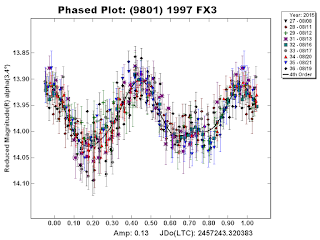E così è giunto anche il momento di figurare in una CBET, un sogno coronato grazie ad un'annata di lavoro straordinaria. L'asteroide (3433) Fehrenbach è stato scoperto essere un binario e il nostro gruppo ha partecipato osservando entrambi gli eventi, primario e secondario. Una soddisfazione grandissima.
Electronic Telegram No. 4201 Central Bureau for Astronomical Telegrams
(3433) FEHRENBACH
D. Pray, Sugarloaf Mountain Observatory, South Deerfield, MA, U.S.A.; P. Pravec, Ondrejov Observatory; A. Marchini, F. Salvaggio, and R. Papini, Dipartimento di Scienze Fisiche, Della Terra e Dell'Ambiente, University of Siena; J. Pollock, D. Caton, and R. Hawkins, Appalachian State University (ASU); V. Benishek, Belgrade Astronomical Observatory; A. Smith, Gemini North; and D. Reichart and J. Haislip, University of North Carolina at Chapel Hill, report that photometric observations taken with a 0.50-m telescope (+ SBIG ST-10XME camera) at the Sugarloaf Mountain Observatory, a 0.30-m telescope (+ SBIG STL-6303 camera) at the Astronomical Observatory of the University of Siena, a 0.35-m telescope (+ Apogee Alta U47+ camera) at the ASU's Dark Sky Observatory near Boone, NC, USA, and a 0.35-m telescope (+ SBIG ST-8 camera)at the Sopot Observatory in Serbia during Oct. 31-Nov. 21 reveal that minor planet (3433) is a binary system with an orbital period of 19.665 +/- 0.005 hr. The primary shows a period of 3.9160 +/- 0.0003 hr and has a lightcurve amplitude of 0.27 mag at solar phases 6-11 degrees. Mutual eclipse/occultation events that are 0.10- to 0.17-magnitude deep indicate the secondary-to-primary mean-diameter ratio of 0.31. The secondary is synchronous, and it has an amplitude of 0.03 mag in the observed lightcurve, suggesting a secondary elongation of about 1.3 after removing contribution of light from the primary. The system's total V magnitude ranged between 14.2 and 15.0 over the observing run.
(C) Copyright 2015 CBAT
2015 November 24 (CBET 4201)
Daniel W. E. Green
MK-C 12" f/5.6 + GM-2000 + STL-6303
Location: Siena































